PVH Bundle
Who Really Owns PVH Corp.?
Unraveling the ownership of a fashion industry titan like PVH Corp. is key to understanding its strategic moves and market dominance. From its humble beginnings in 1881, PVH has transformed into a global powerhouse, marked by pivotal acquisitions like Tommy Hilfiger and The Warnaco Group. Knowing the PVH SWOT Analysis can help you understand the company better.
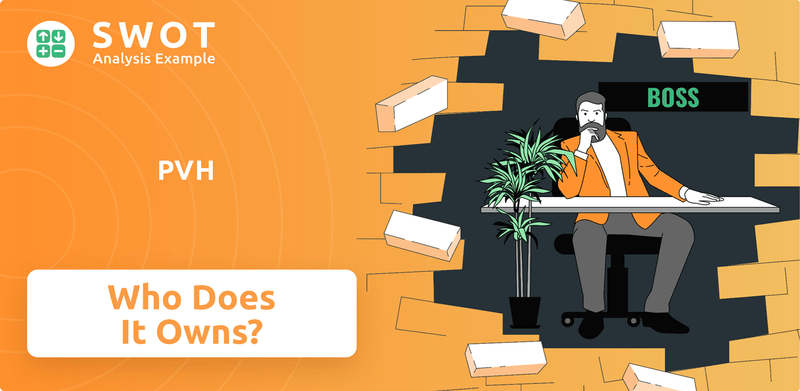
This exploration into PVH Company ownership will reveal the evolution of its ownership structure, from its founders to its current major stakeholders. Understanding Who owns PVH is crucial for investors considering PVH stock or anyone interested in the PVH history and strategic direction of one of the world's largest apparel companies. We'll examine the role of the board of directors and voting power, and recent developments that shape the future of PVH Corporation owner.
Who Founded PVH?
The story of PVH Company, formerly known as Phillips-Van Heusen Corporation, begins in 1881. Moses Phillips and his wife, Endel Phillips, laid the foundation for what would become a global apparel giant. They started a shirt-sewing business from their home in Pottsville, Pennsylvania, selling shirts directly to local coal miners.
This humble beginning marked the genesis of a company that would evolve significantly over the decades. The family-run enterprise, initially called M. Phillips & Son, later moved to New York City. This move was a crucial step in expanding their reach and establishing a foothold in the burgeoning garment industry.
In 1907, the Phillips family merged their business with D. Jones & Son, a shirt and collar maker established around 1865 by Prussian immigrant Dramin Jones. This merger formed the Phillips-Jones Corporation, setting the stage for future growth and strategic partnerships.
The 1919 partnership with inventor John Manning Van Heusen, who developed a soft-folding collar, was pivotal. This collaboration led to the creation of the 'Van Heusen collar,' a product that would become synonymous with the brand.
In 1919, Phillips-Jones Corporation went public, listing on the New York Stock Exchange. This move provided access to capital and marked a significant transition for the company.
In 1957, the company officially changed its name to Phillips-Van Heusen Corporation, reflecting the importance of the Van Heusen brand and partnership.
Seymour J. Phillips, grandson of the founders, later became president. He shifted the company's focus towards research, quality control, and advertising.
Specific details about the initial capital, equity splits, or early backers beyond the founders and the merger with D. Jones & Son are not readily available.
The early years were marked by strategic partnerships and a focus on innovation, particularly in collar technology. The company's evolution from a family business to a publicly traded corporation showcases its growth.
The ownership of PVH Company has evolved significantly since its inception. Initially, the company was a family-run business founded by Moses and Endel Phillips. The merger with D. Jones & Son and the subsequent partnership with John Manning Van Heusen were crucial steps in its early development. The transition to a publicly traded company in 1919, with its listing on the New York Stock Exchange, brought in external investors and marked a significant change in the company's ownership structure. Today, understanding the Growth Strategy of PVH is essential for investors.
- Moses Phillips and Endel Phillips: Founders of the original shirt-sewing business.
- D. Jones & Son: Merged with Phillips to form Phillips-Jones Corporation.
- John Manning Van Heusen: Partnered with the company, leading to the 'Van Heusen' brand.
- Public Shareholders: Became part of the ownership structure after the company went public in 1919.
PVH SWOT Analysis
- Complete SWOT Breakdown
- Fully Customizable
- Editable in Excel & Word
- Professional Formatting
- Investor-Ready Format
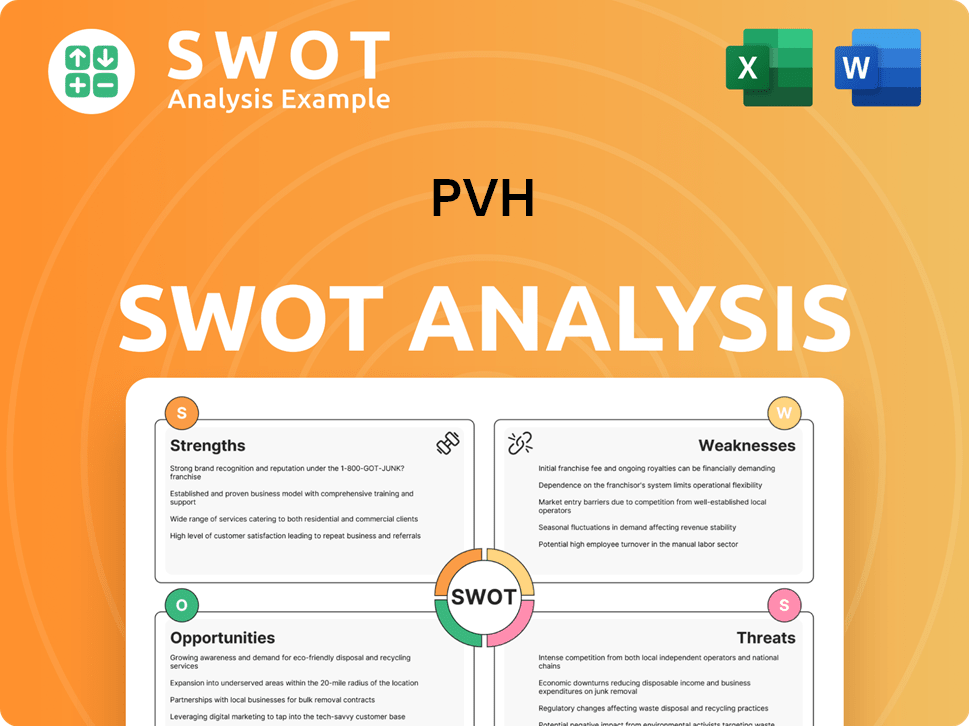
How Has PVH’s Ownership Changed Over Time?
The ownership structure of PVH Corp. has evolved significantly since its initial public offering. Initially known as Phillips-Jones Corporation, the company has experienced major shifts in shareholding, particularly in the 21st century. Strategic acquisitions have played a crucial role, with key milestones including the acquisition of Calvin Klein in 2002 and Tommy Hilfiger in 2010. The purchase of The Warnaco Group Inc. in 2013 was especially significant, consolidating global jeans and underwear businesses under the Calvin Klein brand. This enhanced PVH's control over a major asset, reshaping its ownership landscape.
These strategic moves have transformed PVH into a company with a diverse ownership base, predominantly influenced by institutional investors. The evolution reflects PVH's growth strategy and its ability to adapt to market changes. The company's history is marked by its ability to integrate and manage major brands, which has influenced its ownership dynamics over time. This has made PVH a key player in the apparel industry, as highlighted in the Competitors Landscape of PVH article.
| Date | Event | Impact on Ownership |
|---|---|---|
| 2002 | Acquisition of Calvin Klein | Expanded brand portfolio, increased institutional interest |
| 2010 | Acquisition of Tommy Hilfiger | Further diversified brand portfolio, attracted new investors |
| 2013 | Acquisition of The Warnaco Group Inc. | Consolidated Calvin Klein's global businesses, enhanced control |
As of May 2025, PVH Corp. has a substantial institutional presence, with 903 institutional owners and shareholders who have filed 13D/G or 13F forms with the SEC. These investors hold a total of 69,880,202 shares. Institutional investors held approximately 113.65% of the company's shares in May 2025, while mutual funds held 88.33%. Major shareholders include Pzena Investment Management LLC, Vanguard Group Inc, and BlackRock, Inc. Insiders held approximately 0.84% of the company's stock in May 2025. These figures highlight the significant influence of large investment firms on PVH's management and stock performance.
PVH's ownership structure is primarily influenced by institutional investors.
- Strategic acquisitions, such as Calvin Klein and Tommy Hilfiger, have significantly shaped its ownership.
- Institutional investors hold a substantial percentage of PVH stock, influencing its market performance.
- Insider ownership, while present, is a smaller portion compared to institutional holdings.
- The company's financial health and strategic decisions are closely watched by major shareholders.
PVH PESTLE Analysis
- Covers All 6 PESTLE Categories
- No Research Needed – Save Hours of Work
- Built by Experts, Trusted by Consultants
- Instant Download, Ready to Use
- 100% Editable, Fully Customizable
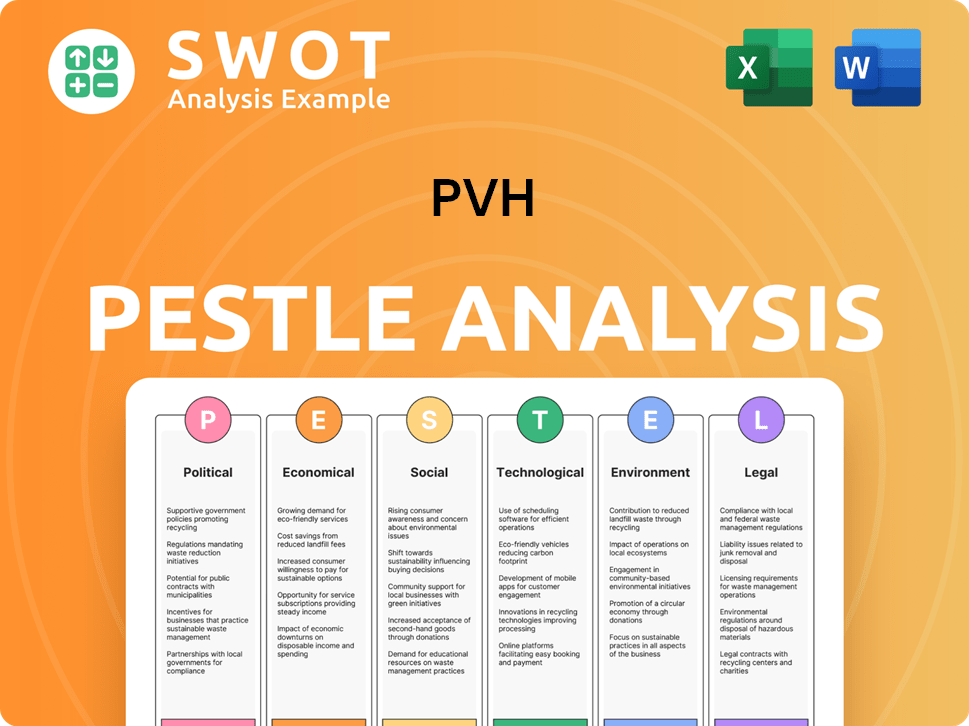
Who Sits on PVH’s Board?
The current board of directors of PVH Corp., as of May 2025, is composed of ten nominees. These individuals are up for re-election annually, determined by a majority vote. Notably, all directors are independent, except for Stefan Larsson, who serves as the Chief Executive Officer. The board includes figures such as Ajay Bhalla, Michael M. Calbert, and Amanda Sourry. Amanda Sourry, for example, holds the position of chair for the Compensation Committee and is a member of the Nominating, Governance & Management Development Committee.
The board's structure ensures robust oversight, with full access to management and the authority to engage independent advisors. Recent initiatives include a board refreshment program, which has seen the addition of four independent directors over the past three years, thereby enhancing diversity among director nominees. The Nominating, Governance & Management Development Committee oversees governance-related risks and is responsible for nominating directors.
| Board Member | Role | Committee Memberships |
|---|---|---|
| Stefan Larsson | Chief Executive Officer | N/A |
| Amanda Sourry | Director | Compensation Committee (Chair), Nominating, Governance & Management Development Committee |
| Ajay Bhalla | Director | N/A |
| Michael M. Calbert | Director | N/A |
| Brent Callinicos | Director | N/A |
| George Cheeks | Director | N/A |
| G. Penny McIntyre | Director | N/A |
| Amy McPherson | Director | N/A |
The voting structure at PVH generally follows a one-share-one-vote principle, with directors elected by a majority of the votes cast. There are no indications of dual-class shares or special voting rights that would grant disproportionate control to specific entities. In 2024, shareholders showed strong support for executive compensation, with over 98% approval, and director elections also received substantial backing, with the lowest support level still exceeding 95% of votes. For the June 18, 2025, annual meeting, stockholders of record as of April 21, 2025, were eligible to vote.
Understanding PVH Company ownership involves looking at its board of directors and voting structure. The board, comprising independent directors and the CEO, oversees the company's strategic direction. The voting process is straightforward, with shareholders having equal voting rights.
- The board of directors is responsible for the strategic oversight of the company.
- Directors are elected annually by a majority of votes.
- The voting structure is primarily one-share-one-vote.
- Shareholders approved executive compensation with over 98% approval in 2024.
PVH Business Model Canvas
- Complete 9-Block Business Model Canvas
- Effortlessly Communicate Your Business Strategy
- Investor-Ready BMC Format
- 100% Editable and Customizable
- Clear and Structured Layout
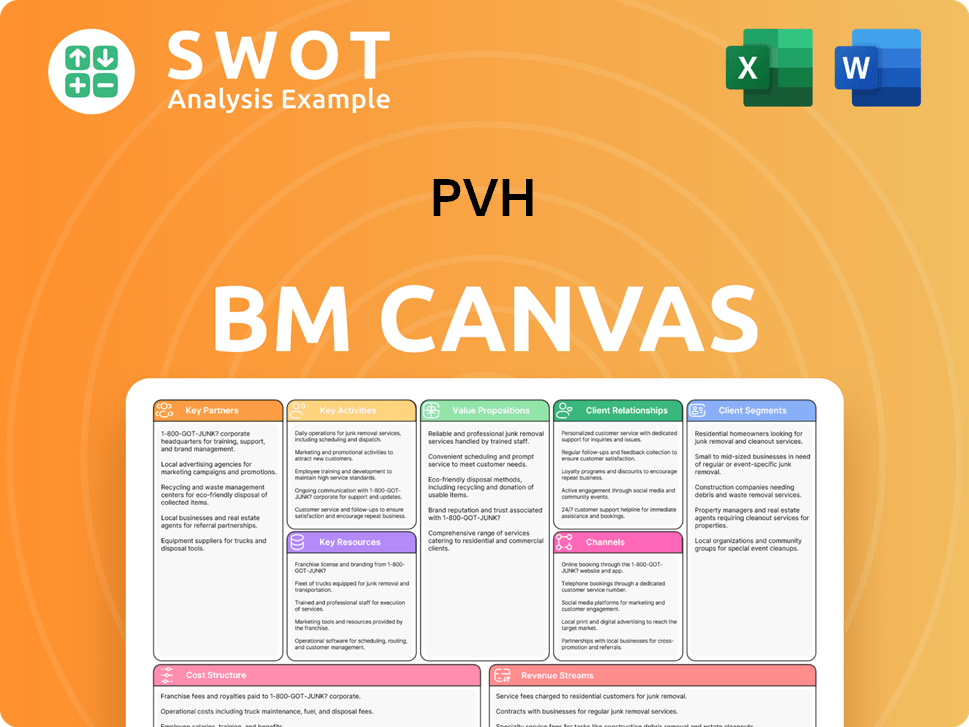
What Recent Changes Have Shaped PVH’s Ownership Landscape?
Over the past few years, the ownership structure of the PVH Company has seen considerable shifts, reflecting strategic realignments. This includes a strong focus on core brands like Calvin Klein and Tommy Hilfiger, while divesting other brands. For instance, in November 2023, the company sold its Heritage Brands women's intimate apparel business to concentrate on its main global brands. In August 2021, the Heritage Brands division, including Izod, Van Heusen, Arrow, and Geoffrey Beene, was sold to Authentic Brands Group. These moves highlight a strategic pivot towards streamlining operations and focusing on key growth areas.
The company's commitment to returning capital to shareholders is evident through its share buyback programs. Approximately $500 million in stock was repurchased during 2024, with plans to repurchase an additional $500 million through Accelerated Share Repurchase (ASR) agreements in 2025. As of February 2, 2025, there was $1.8 billion available under the company's $5 billion stock repurchase authorization. The 2025 ASR is expected to repurchase about 7.7 million shares, representing roughly 14% of the company's weighted average diluted shares outstanding during the fourth quarter of fiscal year 2024. These actions underscore the company's confidence and commitment to shareholder value.
| Metric | Details | Data |
|---|---|---|
| Institutional Ownership (May 2025) | Percentage of shares held by institutional investors | 113.65% |
| Mutual Fund Ownership (May 2025) | Percentage of shares held by mutual funds | 88.33% |
| Insider Ownership Increase (May 2025) | Increase in insider holdings | From 0.82% to 0.84% |
| 2024 Stock Repurchase | Amount of stock repurchased | Approximately $500 million |
| 2025 Planned Stock Repurchase | Amount of stock planned to repurchase | $500 million |
From an ownership perspective, institutional investors hold a significant portion of shares. In May 2025, institutional investors held 113.65% of shares, and mutual funds held 88.33%. Insiders increased their holdings from 0.82% to 0.84% in May 2025. Further streamlining efforts include a headcount cost reduction initiative from August 2022 and a multi-year initiative to simplify its operating model. The company is also bringing in-house a significant portion of product categories previously licensed to G-III Apparel Group, Ltd. These strategic decisions reflect the company's goal to build Calvin Klein and Tommy Hilfiger into highly desirable lifestyle brands, as detailed in Brief History of PVH.
The ownership structure of the PVH Company is primarily influenced by institutional investors and mutual funds, indicating a high degree of public market participation. This ownership structure is crucial in understanding the company's strategic direction and financial performance.
Institutional investors and mutual funds are the primary owners of the PVH Company, with significant holdings. Insiders also hold a portion of the shares, reflecting their confidence in the company's future. This ownership mix is typical for a publicly traded company.
PVH Company owns and operates iconic brands like Calvin Klein and Tommy Hilfiger. These brands are central to the company's strategic focus and growth initiatives. The company's brand portfolio is geared towards lifestyle and fashion.
The company's stock performance is influenced by its strategic decisions, including brand focus and capital allocation. PVH's financial performance in 2025 is projected to be flat to slightly increased revenue compared to 2024, with a similar outlook for operating margins on a non-GAAP basis.
PVH Porter's Five Forces Analysis
- Covers All 5 Competitive Forces in Detail
- Structured for Consultants, Students, and Founders
- 100% Editable in Microsoft Word & Excel
- Instant Digital Download – Use Immediately
- Compatible with Mac & PC – Fully Unlocked
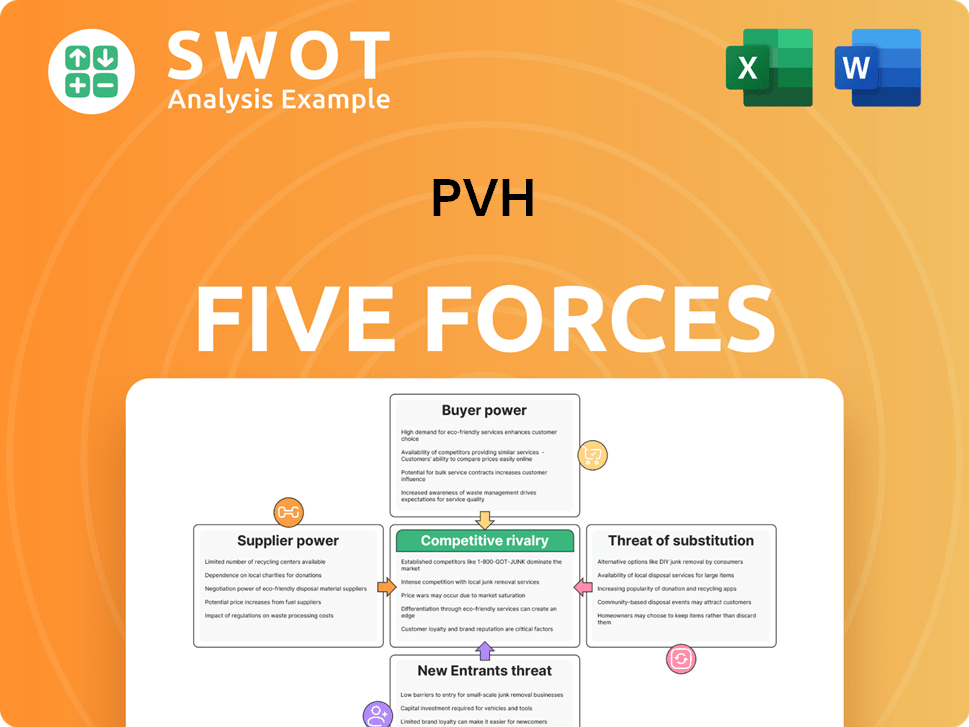
Related Blogs
- What are Mission Vision & Core Values of PVH Company?
- What is Competitive Landscape of PVH Company?
- What is Growth Strategy and Future Prospects of PVH Company?
- How Does PVH Company Work?
- What is Sales and Marketing Strategy of PVH Company?
- What is Brief History of PVH Company?
- What is Customer Demographics and Target Market of PVH Company?
Disclaimer
All information, articles, and product details provided on this website are for general informational and educational purposes only. We do not claim any ownership over, nor do we intend to infringe upon, any trademarks, copyrights, logos, brand names, or other intellectual property mentioned or depicted on this site. Such intellectual property remains the property of its respective owners, and any references here are made solely for identification or informational purposes, without implying any affiliation, endorsement, or partnership.
We make no representations or warranties, express or implied, regarding the accuracy, completeness, or suitability of any content or products presented. Nothing on this website should be construed as legal, tax, investment, financial, medical, or other professional advice. In addition, no part of this site—including articles or product references—constitutes a solicitation, recommendation, endorsement, advertisement, or offer to buy or sell any securities, franchises, or other financial instruments, particularly in jurisdictions where such activity would be unlawful.
All content is of a general nature and may not address the specific circumstances of any individual or entity. It is not a substitute for professional advice or services. Any actions you take based on the information provided here are strictly at your own risk. You accept full responsibility for any decisions or outcomes arising from your use of this website and agree to release us from any liability in connection with your use of, or reliance upon, the content or products found herein.